Text Essay 3
Buddhist Places
Introduction: Buddhism’s Most Sacred
Place
In the centuries and millennia following the death of the Buddha,
his teachings spread across Asia and, more recently, the western
world. Over time, the Buddha’s dharma
evolved so that a Buddhist in Japan might find little in common
with a follower in Vietnam, Thailand, Sri Lanka, Tibet, or Los Angeles.
Nonetheless, however they find it, all Buddhists aspire to achieve
nirvana,
just as Siddhartha Gautama did beneath the Bodhi
tree at Bodh Gaya, in northeastern India, all those years ago.
About eight centuries ago, however, Buddhism disappeared from India
even as it thrived throughout the rest of Asia. Although pilgrims
continued to travel to this holy site, temples and stupas
built to commemorate this moment of enlightenment were buried under
windblown sands. The Bodhi tree died away.
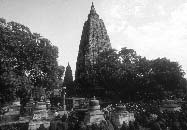 In
the nineteenth century, the British rulers of India began to restore
the temple complex at Bodh Gaya. They cleared away the sand and
planted a cutting of a descendant of the bodhi tree that had been
nurtured for millennia in Sri Lanka, far to the south. Devout Buddhists
from Burma (Myanmar) completed the restoration, and today Bodh Gaya
hosts devoted pilgrims from across the globe. In
the nineteenth century, the British rulers of India began to restore
the temple complex at Bodh Gaya. They cleared away the sand and
planted a cutting of a descendant of the bodhi tree that had been
nurtured for millennia in Sri Lanka, far to the south. Devout Buddhists
from Burma (Myanmar) completed the restoration, and today Bodh Gaya
hosts devoted pilgrims from across the globe.
Bodh Gaya is a success story. But other sacred sites are still
in peril.
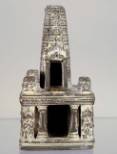 More
about this artwork: After attaining enlightenment, the Buddha
spent seven weeks in meditating in Bodh Gaya and deciding how to
spread his teaching. His first disciples, some traditions believe,
also instantly achieved enlightenment. Many pilgrims have traveled
to this sacred site hoping that they too will become among the 1,002
worshipers that some forms of Buddhism claim will find nirvana at
Bodh Gaya. About 900 years ago a devout pilgrim bought this model
of the main temple at Bodh Gaya and brought it to his or her home
inTibet as a devotional object. More
about this artwork: After attaining enlightenment, the Buddha
spent seven weeks in meditating in Bodh Gaya and deciding how to
spread his teaching. His first disciples, some traditions believe,
also instantly achieved enlightenment. Many pilgrims have traveled
to this sacred site hoping that they too will become among the 1,002
worshipers that some forms of Buddhism claim will find nirvana at
Bodh Gaya. About 900 years ago a devout pilgrim bought this model
of the main temple at Bodh Gaya and brought it to his or her home
inTibet as a devotional object.
Around 250 B.C. the Emperor Ashoka, who ruled much of India, built
a grand complex at Bodh Gaya. It was rebuilt in the second century
A.D. and later repaired in the eleventh century by Burmese Buddhists.
Because of this, the central Mahabodhi temple resembles a Burmese-style
stupa, which takes the form of a narrow
pyramid.
Stupas have been erected throughout the Buddhist world, and many
contain relics of the Historical Buddha or great teachers and saints;
they also remind believers of the Buddha’s enlightenment and
stand as symbols of his teachings. The first stupas in India had
a square base, a round central section, and an umbrella form at
top. A pole that passes through the center links the relics to the
heavens and the earth. In China, Japan, and Korea, the stupa evolved
into the pagoda, and in some traditions,
small stupas are included in personal altars.
Model of Bodh
Gaya
Schist
India, 11-12th century
Pacific Asia Museum Collection
Gift of David Kamansky in honor of Richard Kelton
Bodh Gaya today
Photograph by Don Farber
1. Earliest Images of the Buddha: Afghanistan
Why do some of the oldest existing images of the Buddha have
European facial features and appear to be wearing togas?
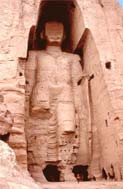 The
Emperor Ashoka, who built what are among the earliest surviving
Buddhist monuments in the third century B.C., sent missionaries
throughout India. Other disciples followed existing trade routes
that stretched across Central Asia. When Buddhism spread north and
west to what are now Pakistan, and Afghanistan, it encountered traditions
of depicting holy figures in human form that came from Greece by
way of Alexander the Great’s armies in the fourth century
B.C. The
Emperor Ashoka, who built what are among the earliest surviving
Buddhist monuments in the third century B.C., sent missionaries
throughout India. Other disciples followed existing trade routes
that stretched across Central Asia. When Buddhism spread north and
west to what are now Pakistan, and Afghanistan, it encountered traditions
of depicting holy figures in human form that came from Greece by
way of Alexander the Great’s armies in the fourth century
B.C.
The valley of Bamiyan, Afghanistan, housed one of the largest Buddhist
centers in Central Asia, including the world’s largest standing
images of the Buddha, built during the second and third centuries
A.D. The earlier smaller Buddha, which stood 136 feet high, wore
robes that resembled Greek or Roman robes, but the larger (186 feet)
Buddha had a more Indian appearance.
Buddhism more or less disappeared from the area in the eleventh
century A.D. The two carvings of the Buddha were destroyed by the
fundamentalist Islamic Taliban in spring 2001, to the great horror
of the world community.
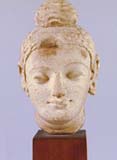 More
about this artwork: This head of the Buddha is an example
of the earliest images of the Buddha in human form, dating from
around the 3rd century AD. It was made in the region of Gandhara,
which is in modern Pakistan, Afghanistan, and northwestern India.
Buddhist sculptures from Gandhara, mostly carved from stone or formed
in clay and coated with stucco, were heavily influenced by Greek
and Roman sculpture, so it displays many Western features. These
images generally have European noses and eyes, their clothing often
resembles Roman togas, and their hair is usually wavy. Here, the
Buddha appears to have his hair tied up in a bun, a princely hairstyle
that may have been the origin of the ushnisha,
the bump on the Buddha's head that has come to symbolize the Buddha's
great spiritual power. More
about this artwork: This head of the Buddha is an example
of the earliest images of the Buddha in human form, dating from
around the 3rd century AD. It was made in the region of Gandhara,
which is in modern Pakistan, Afghanistan, and northwestern India.
Buddhist sculptures from Gandhara, mostly carved from stone or formed
in clay and coated with stucco, were heavily influenced by Greek
and Roman sculpture, so it displays many Western features. These
images generally have European noses and eyes, their clothing often
resembles Roman togas, and their hair is usually wavy. Here, the
Buddha appears to have his hair tied up in a bun, a princely hairstyle
that may have been the origin of the ushnisha,
the bump on the Buddha's head that has come to symbolize the Buddha's
great spiritual power.
The Chinese monk Xuanzang, who traveled to India and back to China
in the seventh century A.D to learn the true teachings of the Buddha,
noted that the two large Buddhas at Bamiyan were gilded and brightly
painted red and blue. More than 20,000 caves had been etched into
the high walls of the cliffs into which the figures were carved,
some decorated with paintings, all from the tradition of Mahayana
Buddhism. Many of these have been destroyed or removed and housed
in private collections and museums around the world.
Bamiyan is a UNESCO World Heritage Site.
Head
of the Buddha
Gandhara (Afghanistan/Pakistan), c.3rd century
AD
Stucco
Pacific Asia Museum Collection
Gift of Dr. Paul Sherbert, 93.41.1
Large Buddha
Bamiyan, Afghanistan, before it was destroyed in 2001
2. Two Thousand Years of Buddhism: Sri Lanka
 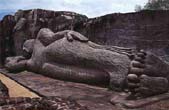 Buddhism
may have vanished from India, but it has been practiced in Sri Lanka,
south of India, for more than two thousand years. Legend proudly
claims that the Buddha himself brought his teachings to the island.
Theravada
Buddhism is still practiced in Sri Lanka today. Buddhism
may have vanished from India, but it has been practiced in Sri Lanka,
south of India, for more than two thousand years. Legend proudly
claims that the Buddha himself brought his teachings to the island.
Theravada
Buddhism is still practiced in Sri Lanka today.
In the twelfth century a king had large stone statues carved of
the Historical
Buddha, and built palaces, gardens, and monasteries at his capital
at Polonnaruwa. The serenity and pose of one of the large Buddhas
is echoed in a small stone Buddha in the museum’s collection
carved during the same era.
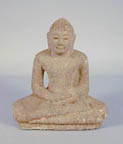 More
about this artwork: This stone figure of the Buddha seated
in a meditation pose is representative of Buddha images from Sri
Lanka, where Buddhism, principally the Theravada
tradition, has been practiced for more than two thousand years.
Buddhist art in Sri Lanka has focused on the life of the Buddha
and on events in his previous lives as a bodhisattva. More
about this artwork: This stone figure of the Buddha seated
in a meditation pose is representative of Buddha images from Sri
Lanka, where Buddhism, principally the Theravada
tradition, has been practiced for more than two thousand years.
Buddhist art in Sri Lanka has focused on the life of the Buddha
and on events in his previous lives as a bodhisattva.
Many Sri Lankan figures are carved from stone or cast in bronze
and then gilded. This Buddha is seated in the meditation pose with
his hands together on his lap. He has an erect back and his eyes
look straight ahead, a posture that is common in Sri Lankan images
of the Buddha. The gentle features and simple treatment of the Buddha's
robe, which clings to his form, are also characteristic.
Two hundred years after the Buddha reached enlightenment under
the Bodhi tree, a disciple brought a cutting from it and planted
it in Sri Lanka, where a descendant of the tree flourishes today.
Among the monumental figures at Gal Vihara, the northern monastery
at Polunnaruwa, is a carving of the Buddha lying on his side at
the moment of his final enlightenment. Carved from a rock outcrop
in the twelfth century, the grain of the rock flows gently along
the length of the Buddha’s body.
Seated Buddha
Sri Lanka, 12th century
Stone
Pacific Asia Museum Collection
Gift of Mark Phillips and Iuliana Phillips, 2001.56.62
Recumbent Buddha
Polunnaruwa, Sri Lanka
3. God-Kings of Khmer: Cambodia
In Cambodia, Buddhism and Hinduism were practiced side by
side for a thousand years. The Angkor temple complex, built by the
Khmer emperors between the ninth and twelfth centuries mixes Hindu
and Buddhist architecture and imagery and includes monuments dedicated
to both Mahayana
and Theravada
forms of Buddhism.
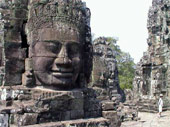 The
Bayon, a temple built in central Cambodia by the Khmer people to
represent the cosmic mountain Meru at the center of the Hindu and
Buddhist universe, also served as a three-dimensional mandala--but
only for the Khmer emperors who built it. Around two hundred faces
of the bodhisattva Avalokiteshvara
look out in all directions from the temple’s towers. They
are said to be carved in the image of the god-king Jayavarman VII. The
Bayon, a temple built in central Cambodia by the Khmer people to
represent the cosmic mountain Meru at the center of the Hindu and
Buddhist universe, also served as a three-dimensional mandala--but
only for the Khmer emperors who built it. Around two hundred faces
of the bodhisattva Avalokiteshvara
look out in all directions from the temple’s towers. They
are said to be carved in the image of the god-king Jayavarman VII.
This small sculpture shows many features typical of the Buddhist
sculpture of the Khmer kingdom of Cambodia, in particular the broad
face and the full, sensuous lips.
Conflict in the late twentieth century damaged portions of the
Angkor complex and made preservation difficult. The area’s
dense jungle has reclaimed parts of Angkor cleared by French archaeologists
in the nineteenth and twentieth centuries.
Angkor is a UNESCO World Heritage Site.
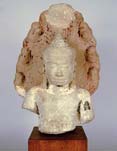 More
about this artwork: This image shows the Buddha being sheltered
by Muchalinda, the King of the Naga Serpents, a depiction that is
popular in Cambodia, where Buddhism has been practiced from around
the middle of the first millennium. The crown-like hairstyle with
the triangular pointed ushnisha,
or cranial bump, is also typical of Khmer images. More
about this artwork: This image shows the Buddha being sheltered
by Muchalinda, the King of the Naga Serpents, a depiction that is
popular in Cambodia, where Buddhism has been practiced from around
the middle of the first millennium. The crown-like hairstyle with
the triangular pointed ushnisha,
or cranial bump, is also typical of Khmer images.
According to Buddhist legend, while the Buddha was meditating,
a powerful storm struck. Muchalinda, a cobra with seven heads, coiled
himself around the Buddha and stretched his hoods out to form an
umbrella over the Buddha's head to shelter him from the rains. Such
images of the Buddha are particularly common Theravada
Buddhist cultures, particularly in Thailand and Cambodia, where
moments in the life of the Historical Buddha
are given great importance. These cultures also revere snakes and
see Muchalinda’s protection of Buddha as a protective act
to imitate and honor.
Torso of the
Buddha Sheltered by Muchalinda
Khmer, Cambodia, 13th century
Stone
Pacific Asia Museum Collection
Gift of Hans and Margot Ries, 1984.96.1
Head of Avalokiteshvara
The Bayon, Angor Wat, Cambodia
4. Uniquely Thai
Originally an outpost of the Khmer empire, Sukhothai in Thailand
became the capital of the Thai state and flourished from the mid-thirteenth
to the late fourteenth centuries. Wooden palaces built in the complex
have crumbled, while stone stu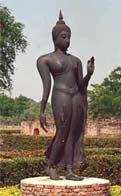 pas
and monumental statues of the Buddha have survived. In the 1970s,
the United Nations Educational, Scientific, and Cultural Organization
(UNESCO) began a restoration of Sukhothai that continued into the
1980s. pas
and monumental statues of the Buddha have survived. In the 1970s,
the United Nations Educational, Scientific, and Cultural Organization
(UNESCO) began a restoration of Sukhothai that continued into the
1980s.
Purely Thai Buddhist styles were first seen at Sukhothai, including
the Walking Buddha. Unique to Thailand and Laos, the Walking Buddha,
his hand raised in a gesture of fearlessness, is sometimes called
“the placing of the Buddha’s footprint.” The Buddha’s
footprints often bear symbols and signs of the Buddha and the Wheel
of the Law.
This Thai bronze image of the Buddha has many features that are
typical of Thai Buddhist figures from the Sukhothai. Both Buddha
and bodhisattva images have elongated faces and graceful, willowy
bodies.
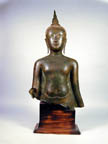 More
about this artwork: In some cases, the Buddha is actually
depicted walking, a posture unique to Thai images. In addition,
the ushnisha,
or lump on the Buddha's head is stretched upwards and ends in the
shape of a flame, another feature that is unique to Thai Buddha
images. The facial features are also very stylized and curvilinear,
with the eyebrows often meeting the line of the nose. This particular
image also has eyes that are inlaid with shell. Because this sculpture
depicts the Buddha with his eyes open, it originally may have been
a Walking Buddha. More
about this artwork: In some cases, the Buddha is actually
depicted walking, a posture unique to Thai images. In addition,
the ushnisha,
or lump on the Buddha's head is stretched upwards and ends in the
shape of a flame, another feature that is unique to Thai Buddha
images. The facial features are also very stylized and curvilinear,
with the eyebrows often meeting the line of the nose. This particular
image also has eyes that are inlaid with shell. Because this sculpture
depicts the Buddha with his eyes open, it originally may have been
a Walking Buddha.
Thailand is one of the Asian cultures that adopted Theravada
Buddhism, a tradition that was transmitted to areas of Southeast
Asia by monks from Sri Lanka around the middle of the first millennium.
Torso of a Standing
Buddha
Thailand, c.15th century
Bronze
Pacific Asia Museum Collection
Gift of Mr. Edward Nagel, 1984.90.8
Standing Buddha
Sukhothai, Thailand
5. Modern Sites: Vietnam
Some Buddhist sites are important because they are relics
of ancient cultures. Others remind us of more recent events. The
Thein Mu Pagoda in Hue, Vietnam, was the home of Thich Quang Duc,
who burned himself to death in 1963 to protest the Vietnamese government’s
persecution of Buddhists. Although self-destruction is against the
deepest beliefs of the Buddhist faith, Thich Quang Duc’s self-immolation
brought world attention to the United States’ support of a
corrupt and intolerant government.
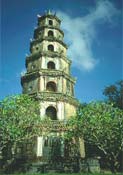 The
Thien Mu Pagoda had long been the hub of intellectual and political
Buddhist activity in Vietnam. It was constructed in 1844 on the
site of a religious center founded in the seventeenth century. It
is sometimes called the Sacred Lady temple because legend has it
that the governor of Hue had a vision of an old woman telling him
that the site had supernatural powers. The
Thien Mu Pagoda had long been the hub of intellectual and political
Buddhist activity in Vietnam. It was constructed in 1844 on the
site of a religious center founded in the seventeenth century. It
is sometimes called the Sacred Lady temple because legend has it
that the governor of Hue had a vision of an old woman telling him
that the site had supernatural powers.
Thien Mu is on UNESCO’s World Heritage List.
Although Vietnam is a communist country, many of its people are
Mahayana
Buddhists and regularly visit the nation’s temples and worship
images such as this figure.
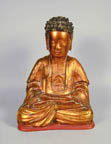 More
about this artwork: This seated Buddha is a good example
of Vietnamese lacquered Buddhist images. Buddha, bodhisattva, and
monk figures are first carved in wood and then coated with layers
of colored lacquer to make them water, heat and insect resistant
as well as colorful. Vietnamese Buddhist lacquered wood figures
tend to be simple in detail and generally have calm, sweet facial
expressions. His ushnisha,
or cranial bump, is also very pronounced, rising out as a copper
mound from among curls of hair. More
about this artwork: This seated Buddha is a good example
of Vietnamese lacquered Buddhist images. Buddha, bodhisattva, and
monk figures are first carved in wood and then coated with layers
of colored lacquer to make them water, heat and insect resistant
as well as colorful. Vietnamese Buddhist lacquered wood figures
tend to be simple in detail and generally have calm, sweet facial
expressions. His ushnisha,
or cranial bump, is also very pronounced, rising out as a copper
mound from among curls of hair.
Seated Buddha
Vietnam, 19th century
Lacquered wood
Pacific Asia Museum Collection
Museum Purchase with funds from the Bressler Foundation, 1996.28.2
Thien Mu Pagoda
Hue, Vietnam
6. Golden Glory of Burma
Burma (Myanmar) first embraced Buddhism around the middle
of the first millennium, following the Mahayana
tradition and then becoming a Theravada
Buddhist kingdom. As in many kingdoms, the form of Buddhist practice
spread in Burma from the king to his followers. This complex was
built by the kings of Pagan, who flourished in what is now Myanmar
from the middle of the eleventh to the end of the thirteenth centuries,
when Kublai Khan overran the kingdom.
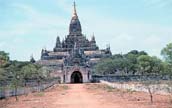 The
Ananda temple is named for one of Buddha’s chief disciples
and represents the infinite wisdom of the Buddha. Built in the early
twelfth century of brick, it is covered in gold leaf. The
Ananda temple is named for one of Buddha’s chief disciples
and represents the infinite wisdom of the Buddha. Built in the early
twelfth century of brick, it is covered in gold leaf.
Unlike most Theravada Buddha images, which have a humble, monk-like
appearance, many Burmese Buddha images are decorated with crowns,
jewelry, and an unusually tall cranial bump, or ushnisha.
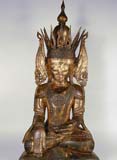 More
about this artwork: The elaborate Burmese style developed
around the 14th century, in part under the influence of the intricate
Buddhist imagery from East India's Pala kingdom. However, such crowned
figures of the Buddha are also said to depict a moment in the life
of the Buddha, when he took on the form of the Universal Monarch,
with a crown, jewels and a beautiful throne, to impress an earthly
king and lead him to Buddhism. As in this image, his sits with one
hand in the Earth
Touching Gesture at the moment of enlightenment. His face is
very round and he has a gentle, sweet expression that is also typical
of Burmese images of the Buddha. More
about this artwork: The elaborate Burmese style developed
around the 14th century, in part under the influence of the intricate
Buddhist imagery from East India's Pala kingdom. However, such crowned
figures of the Buddha are also said to depict a moment in the life
of the Buddha, when he took on the form of the Universal Monarch,
with a crown, jewels and a beautiful throne, to impress an earthly
king and lead him to Buddhism. As in this image, his sits with one
hand in the Earth
Touching Gesture at the moment of enlightenment. His face is
very round and he has a gentle, sweet expression that is also typical
of Burmese images of the Buddha.
Crowned Buddha
Burma (Myanmar), 19th century
Lacquered and gilded wood
Pacific Asia Museum Collection
Gift of Union Bank of California, 2001.25.1
Ananda Temple
Pagan, Burma (Myanmar)
7. China’s Long Legacy
Throughout Asia, Buddhist leaders built many monumental testimonies
to their faith: huge temple complexes, towering statues, precious
building materials. The Longmen cave temples in Henan province,
China, have to be some of the most impressive. Begun at the end
of the fifth century, the project continued without a break for
four hundred years by Buddhist rulers of the Northern Wei and Tang
dynasties.
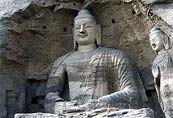 Generations
of sculptors carved statues of the Buddha, bodhisattvas, and guardian
figures from limestone, adding inscriptions that honor patrons.
The Empress Wu (reign 690-705) is commemorated, legend goes, in
the face of the Cosmic Buddha. Generations
of sculptors carved statues of the Buddha, bodhisattvas, and guardian
figures from limestone, adding inscriptions that honor patrons.
The Empress Wu (reign 690-705) is commemorated, legend goes, in
the face of the Cosmic Buddha.
Buddhism first arrived in China around the first century AD along
the Silk Road and was eventually the largest Asian nation to adopt
the faith. Over the centuries, Buddhism and its arts enjoyed periods
of glory and decline under the nations various rulers.
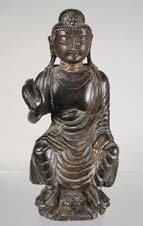 This
bronze figure dates to the Ming dynasty (1368-1644), when Chinese
Buddhism was influenced by Tibetan Buddhism. This
bronze figure dates to the Ming dynasty (1368-1644), when Chinese
Buddhism was influenced by Tibetan Buddhism.
More about this artwork: This bronze
figure shows traditional Chinese features, such as the fleshy cheeks,
the highly stylized and linear facial features, and the ornate patterning
on the borders of his robes. The toga-like folds of the robes and
the leggings recall the Buddha figures of Gandahar. Unlike more
meditative statues, this Buddha holds its hand aloft in a gesture
of fearlessness.
Figurine of the
Buddha
China, Tang dynasty (618-906 AD)
Bronze and gilt
Pacific Asia Museum Collection
Gift of Mr. and Mrs. Joseph Kamansky, 1991.70.2
Longmen Caves
Henan Province, China
8. A Perfect Place: Tibet
A mandala is a model or a map of a perfected environment,
most often a symbolic depiction of the world of a Buddhist deity.
Mandalas are used by Vajrayana Buddhists
of Tibet and Mahayana Buddhists to
practice concentration and to cultivate inner vision, picturing
themselves present within the perfected environment. From here,
the deity can help them to progress towards a perfected state of
enlightenment.
 Tibetan
mandalas can be painted, printed, embroidered, or created in sand,
often in the floor plan of a palace; sometimes three-dimensional
mandalas are constructed. Tibetan
mandalas can be painted, printed, embroidered, or created in sand,
often in the floor plan of a palace; sometimes three-dimensional
mandalas are constructed.
The Potala Palace in Lhasa, Tibet, is part city hall, fortress,
and monastery and, until 1959 when the Chinese took control of Tibet,
it served as the home of the Dalai Lama. Work began on the palace
in 1645 under the Fifth Dalai Lama and was concluded in 1695. It
was named after Potalaka, the Buddhist paradise (or pure land) of
the compassionate bodhisattva Avalokiteshvara.
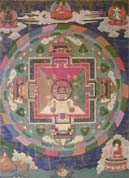 More
about these images: This particular mandala depicts the sacred
abode, or perfected environment, of the Buddha, who sits in the
lower right-hand corner of the mandala, and four bodhisattvas. Inside
the circle are structures showing the four main gates and the floor
plan of the sacred space. Also inside are lotuses, clouds, and vajras. More
about these images: This particular mandala depicts the sacred
abode, or perfected environment, of the Buddha, who sits in the
lower right-hand corner of the mandala, and four bodhisattvas. Inside
the circle are structures showing the four main gates and the floor
plan of the sacred space. Also inside are lotuses, clouds, and vajras.
The grandeur of the Potala Palace owes much to its hilltop location
and its formidable appearance. Its powerful appearance symbolizes
the union of the spiritual and the political, and it serves as a
symbol to the Tibetan people of the Dalai Lama’s authority
even in exile.
Painting of a Buddhist
Mandala
Tibet, 18th century,
Ink and gold on paper
Pacific Asia Museum Collection
Estate of Mr. and Mrs. Wilmont Gordon, 1990.14.57
Potala Palace
Lhasa, Tibet

|
![]()